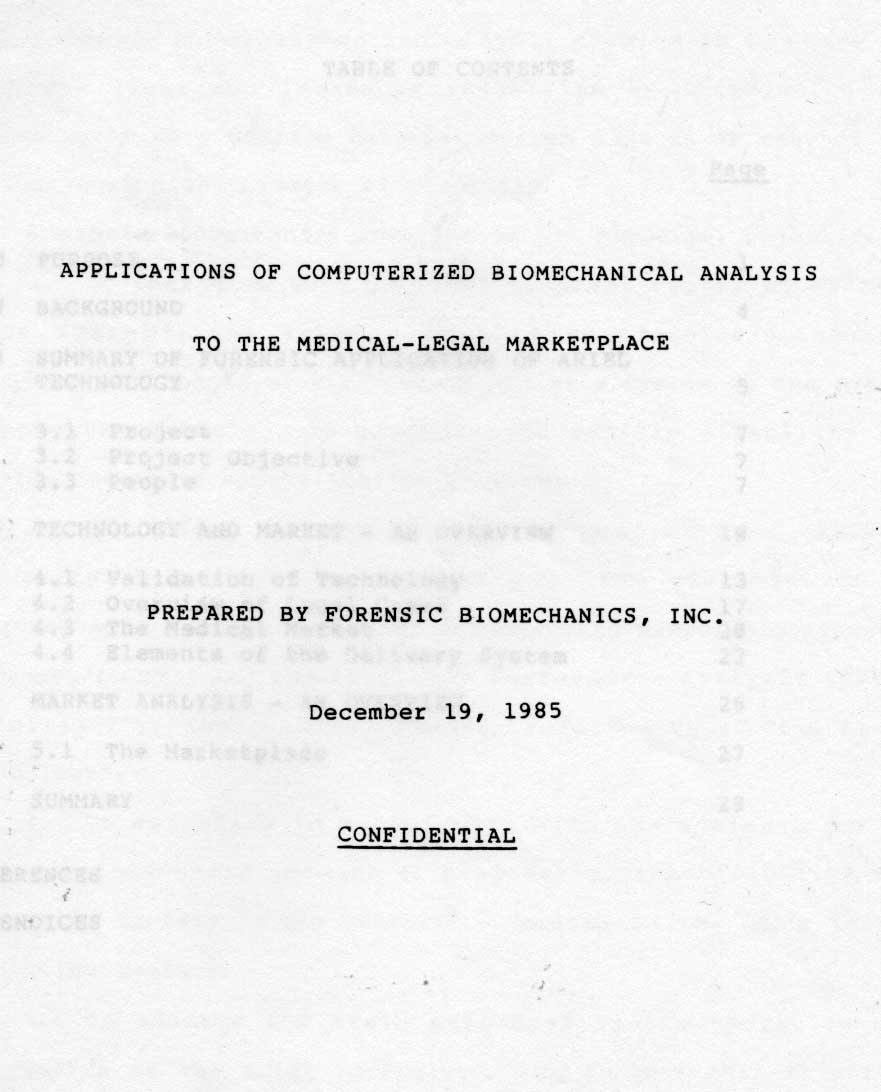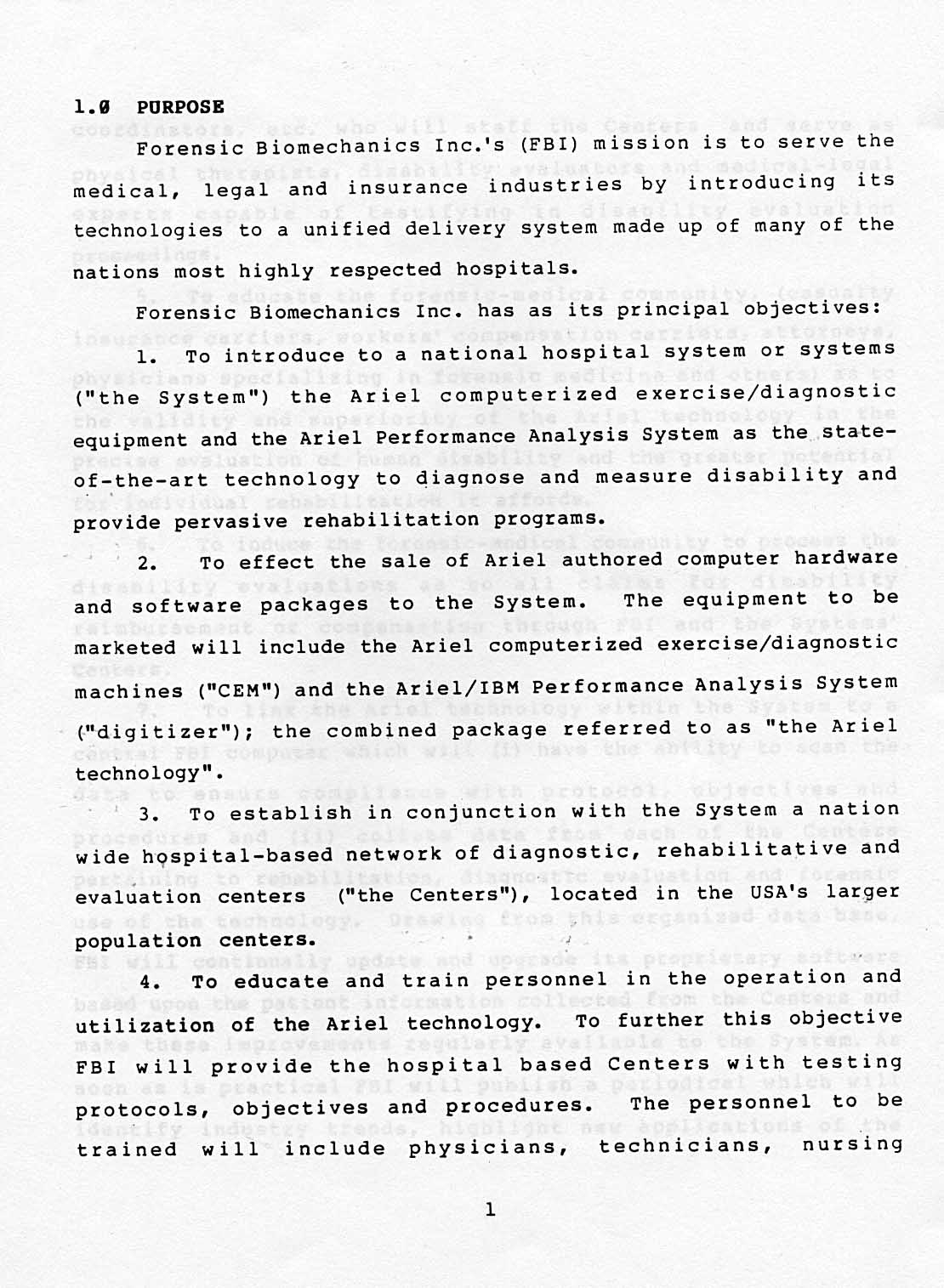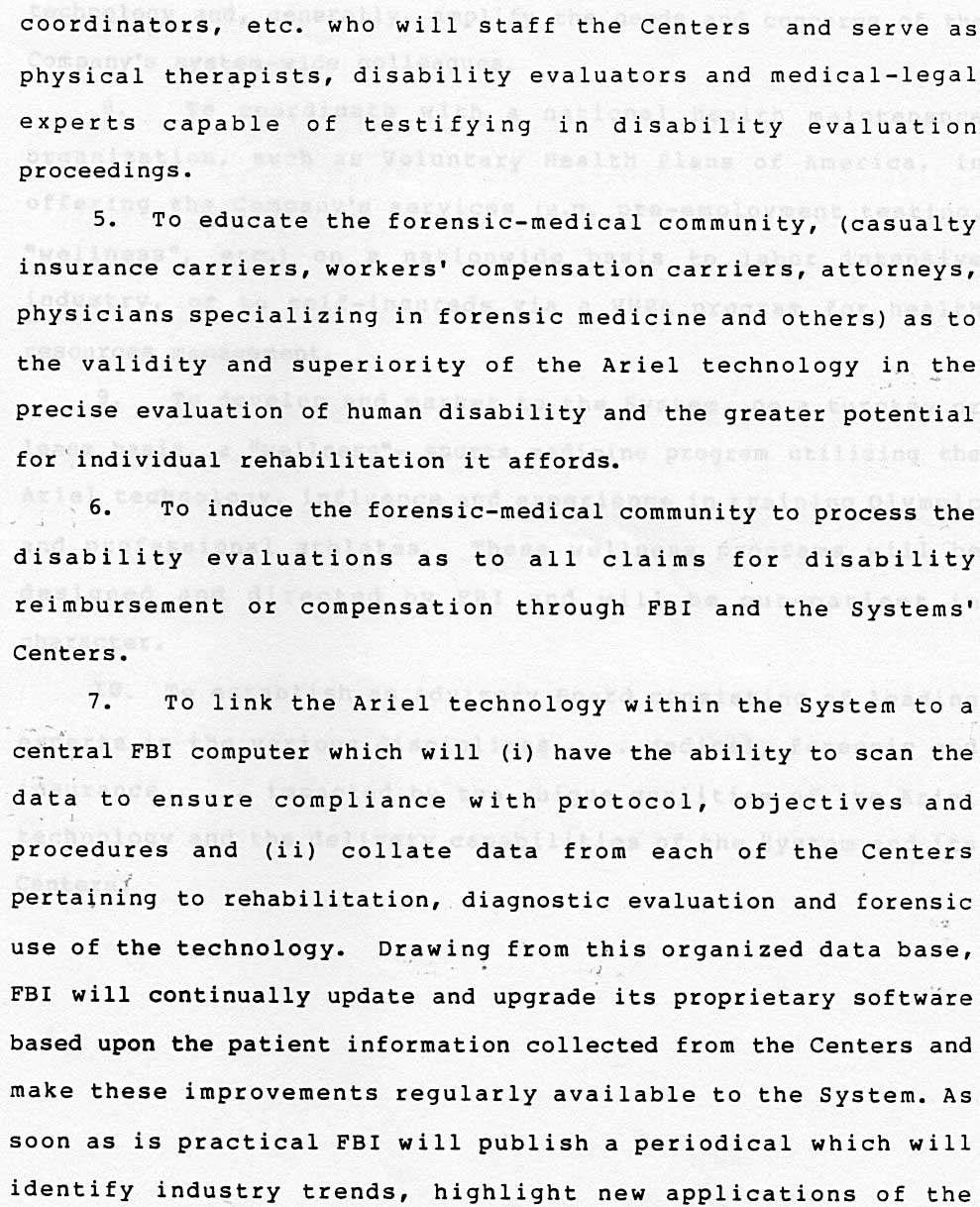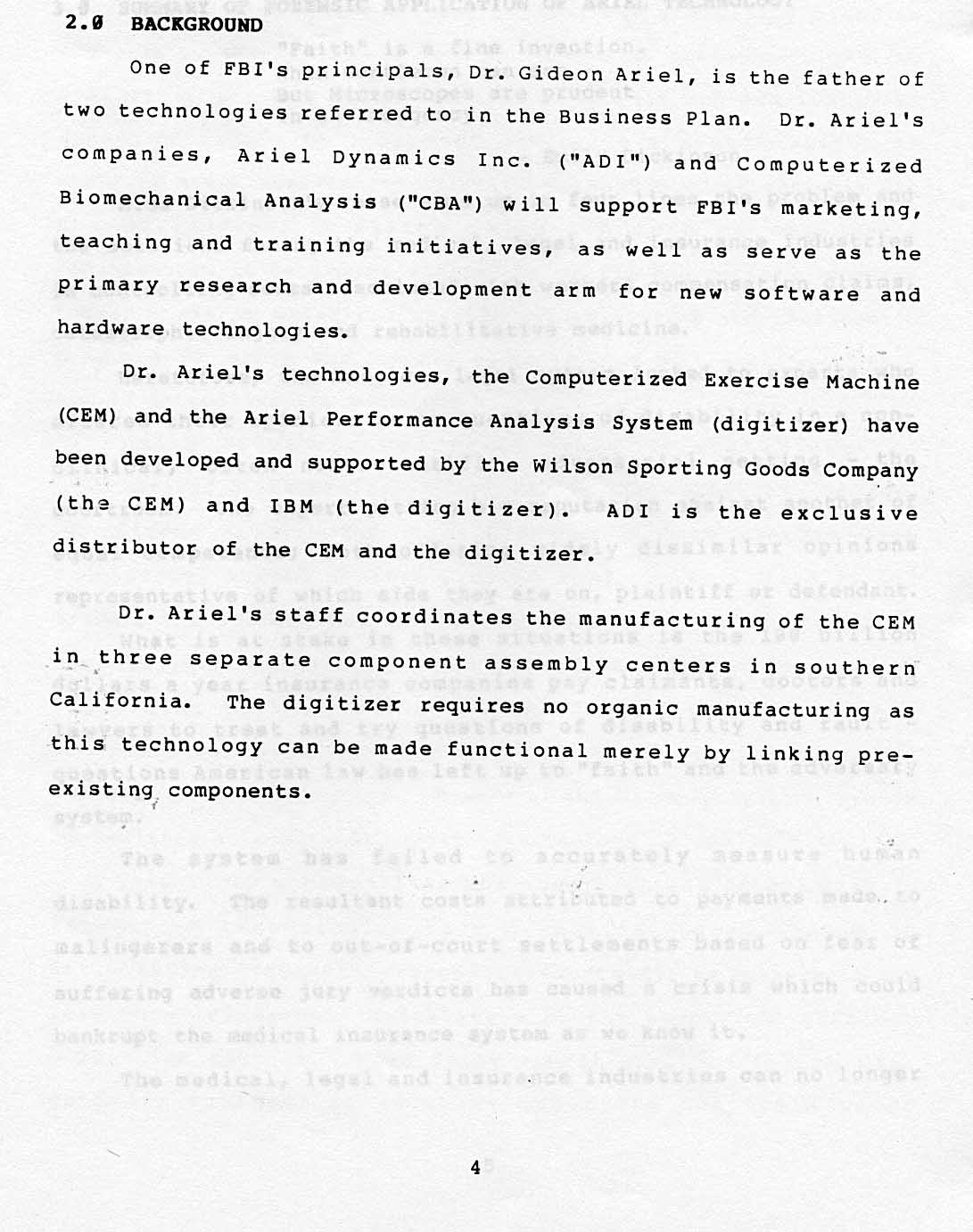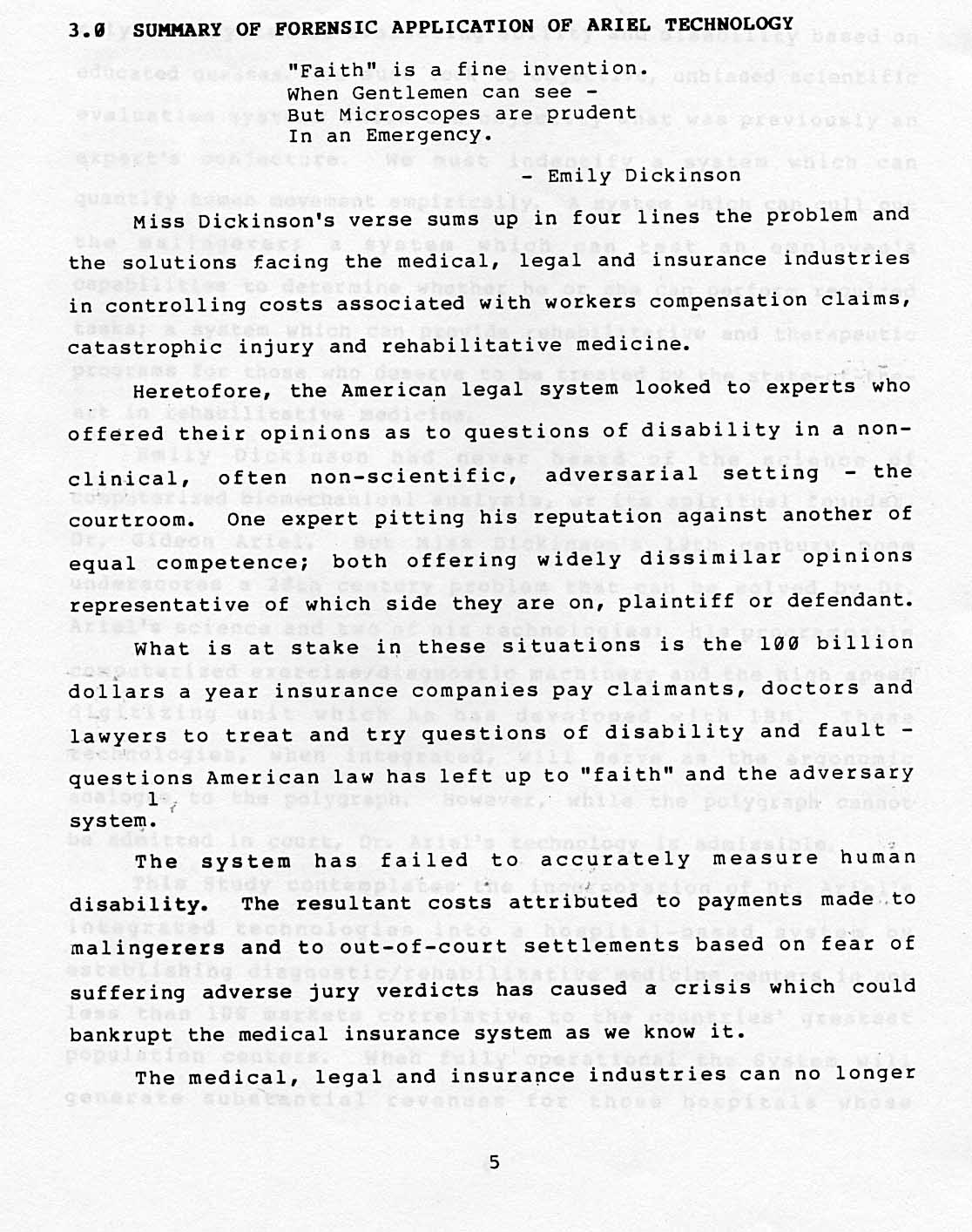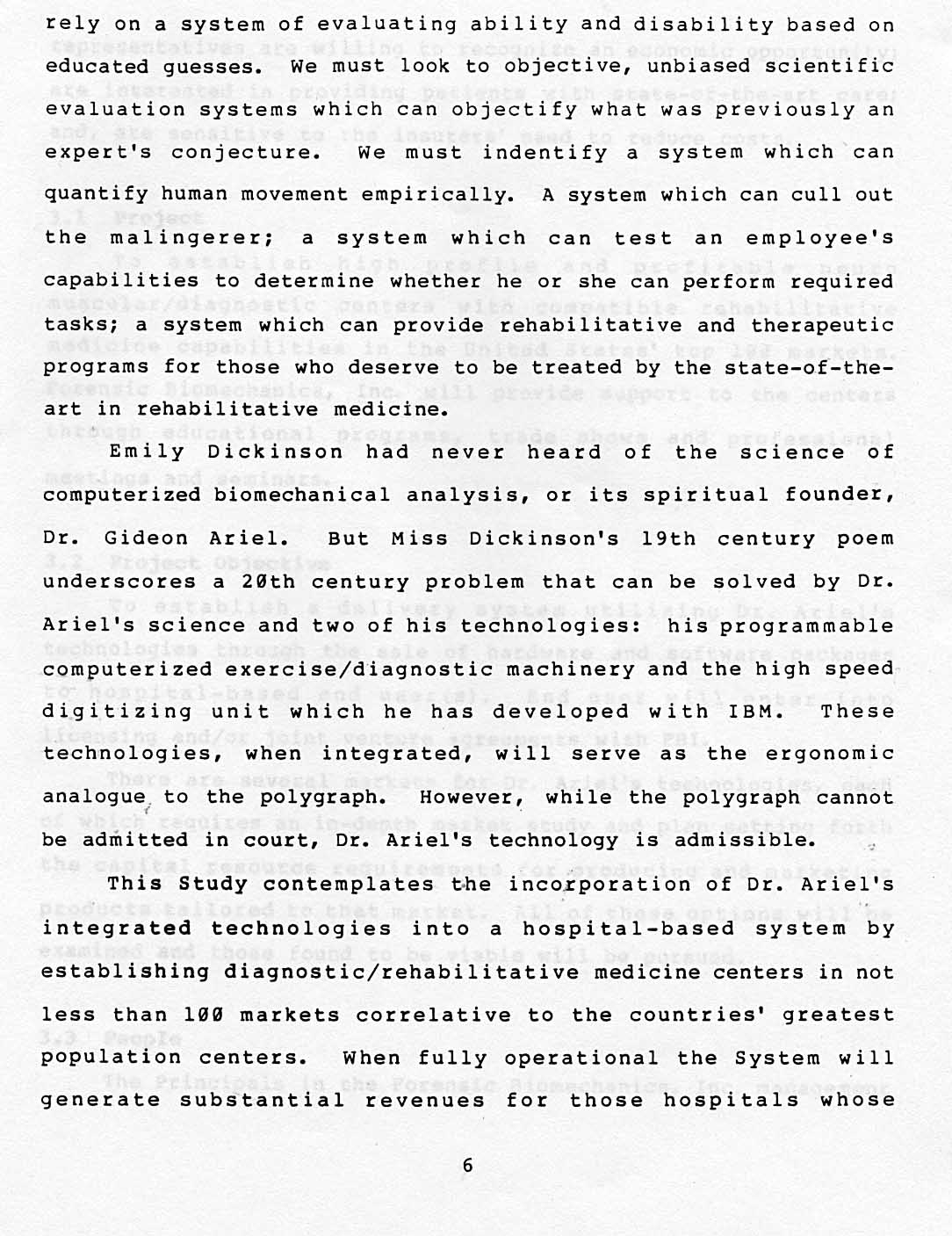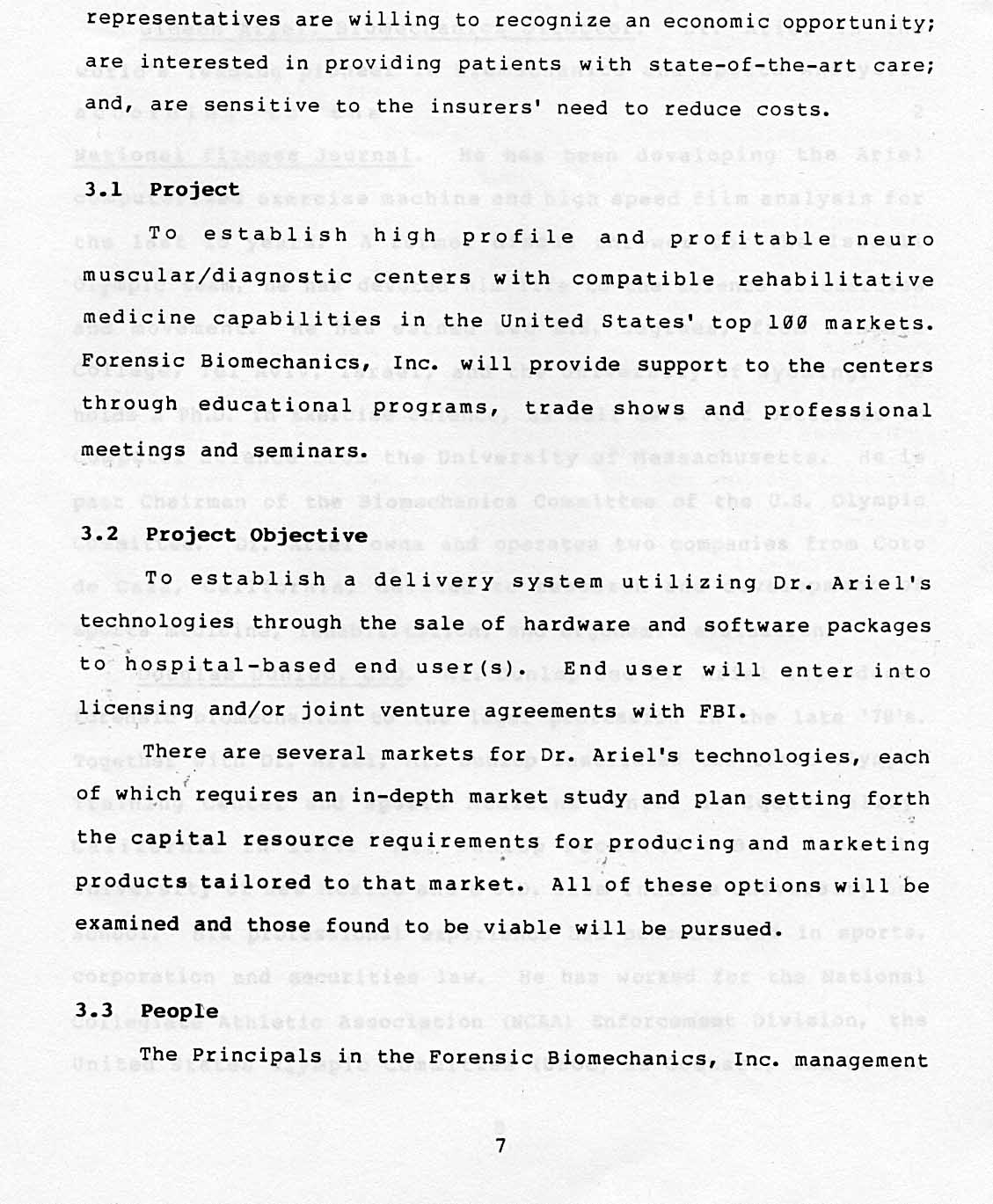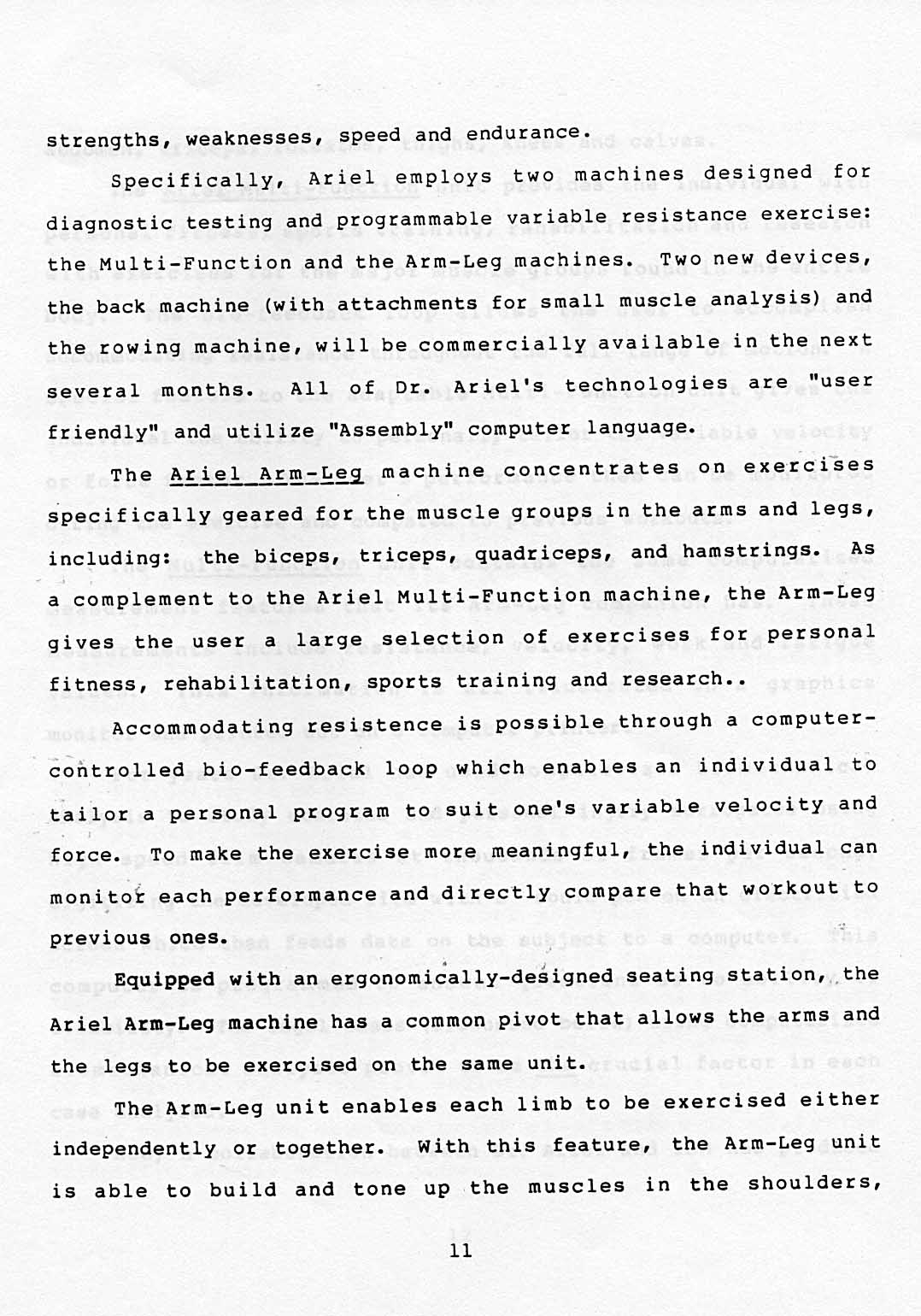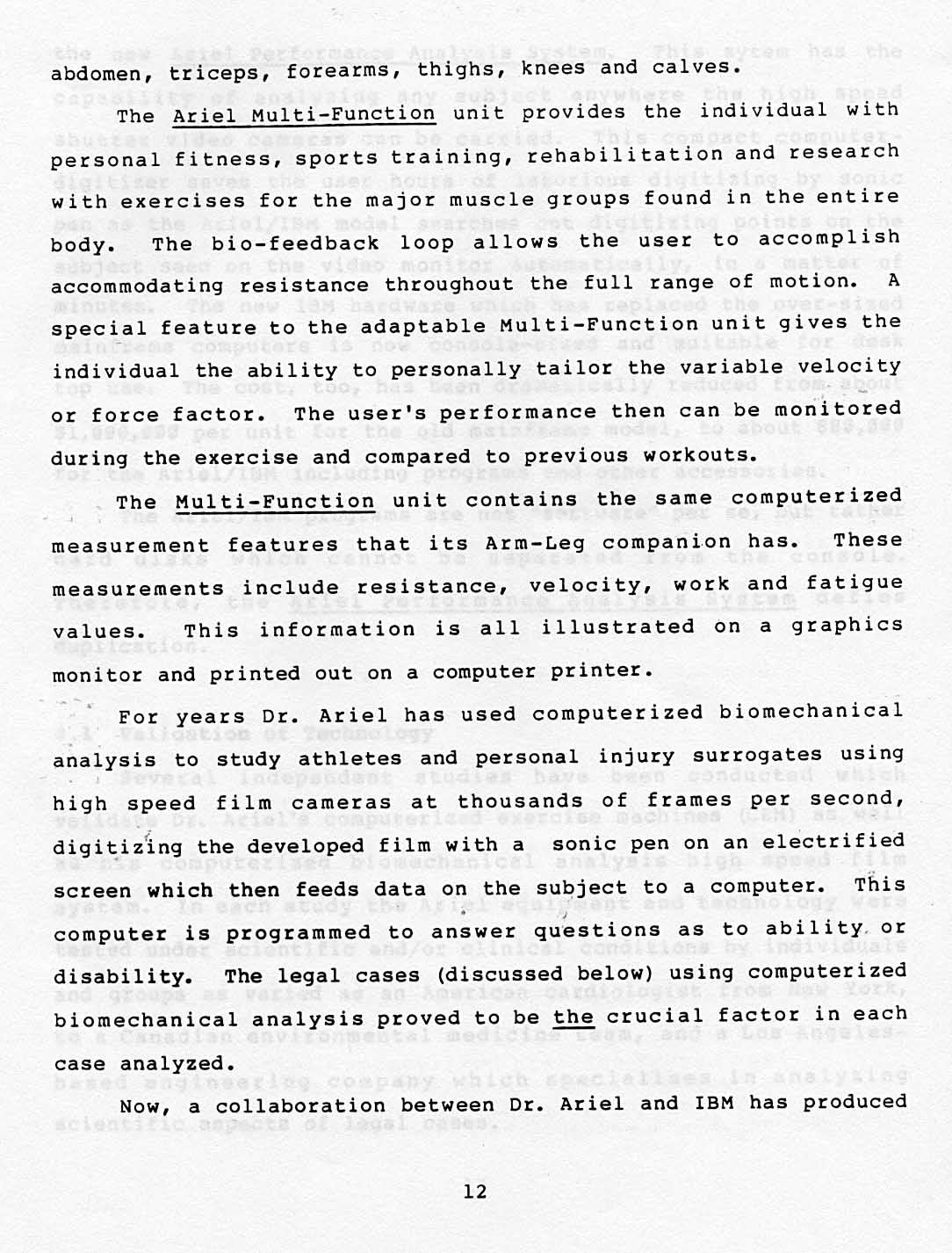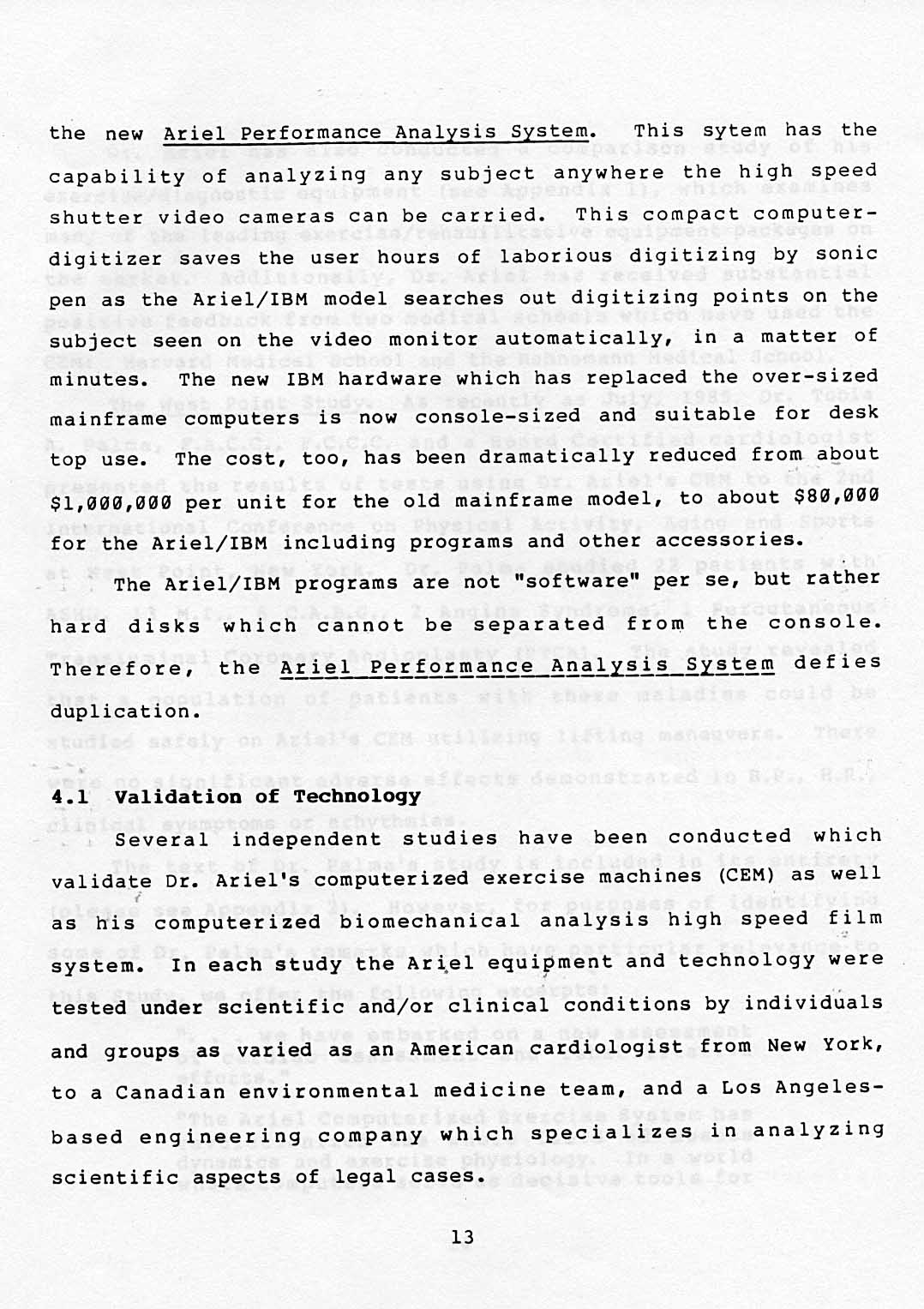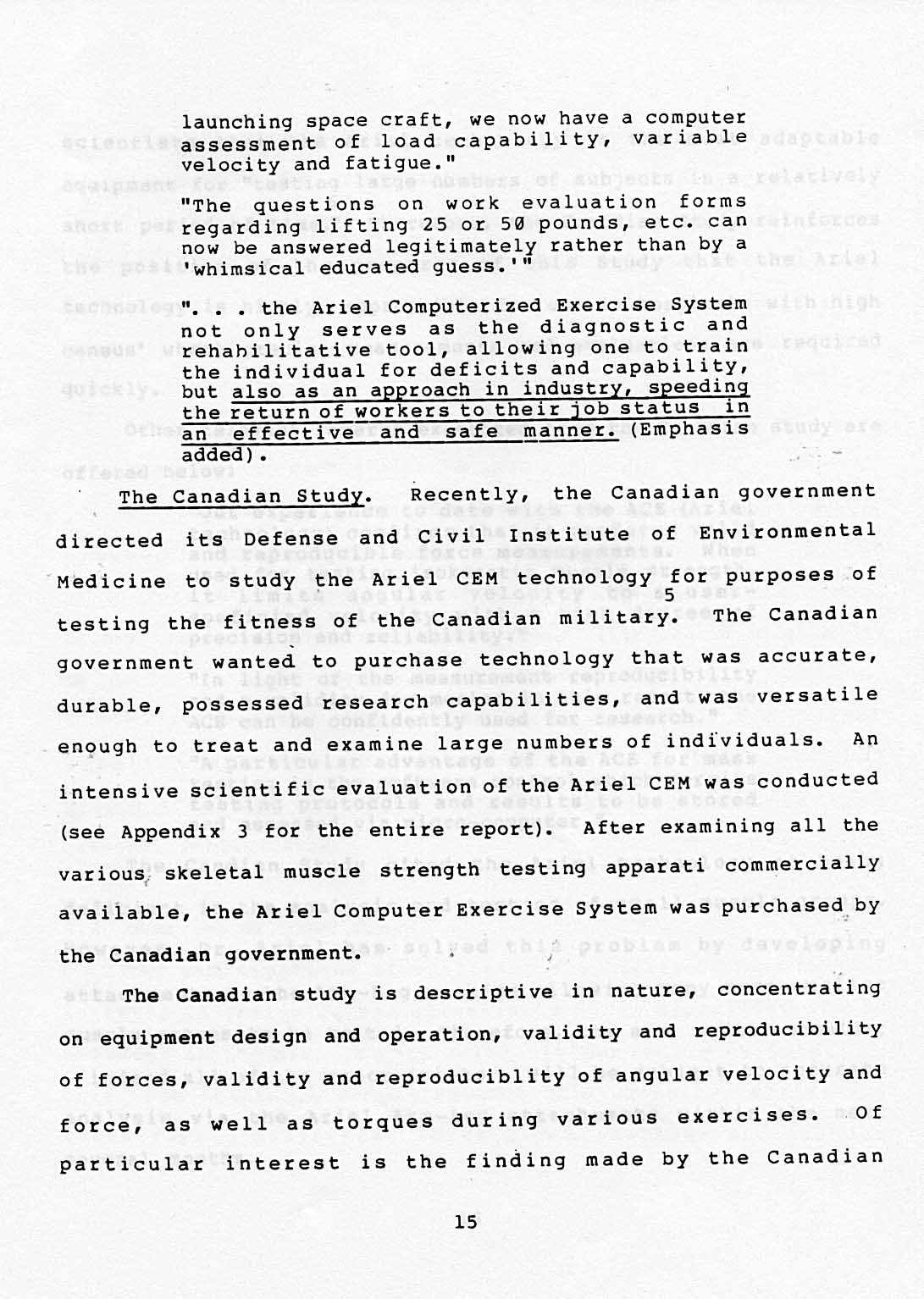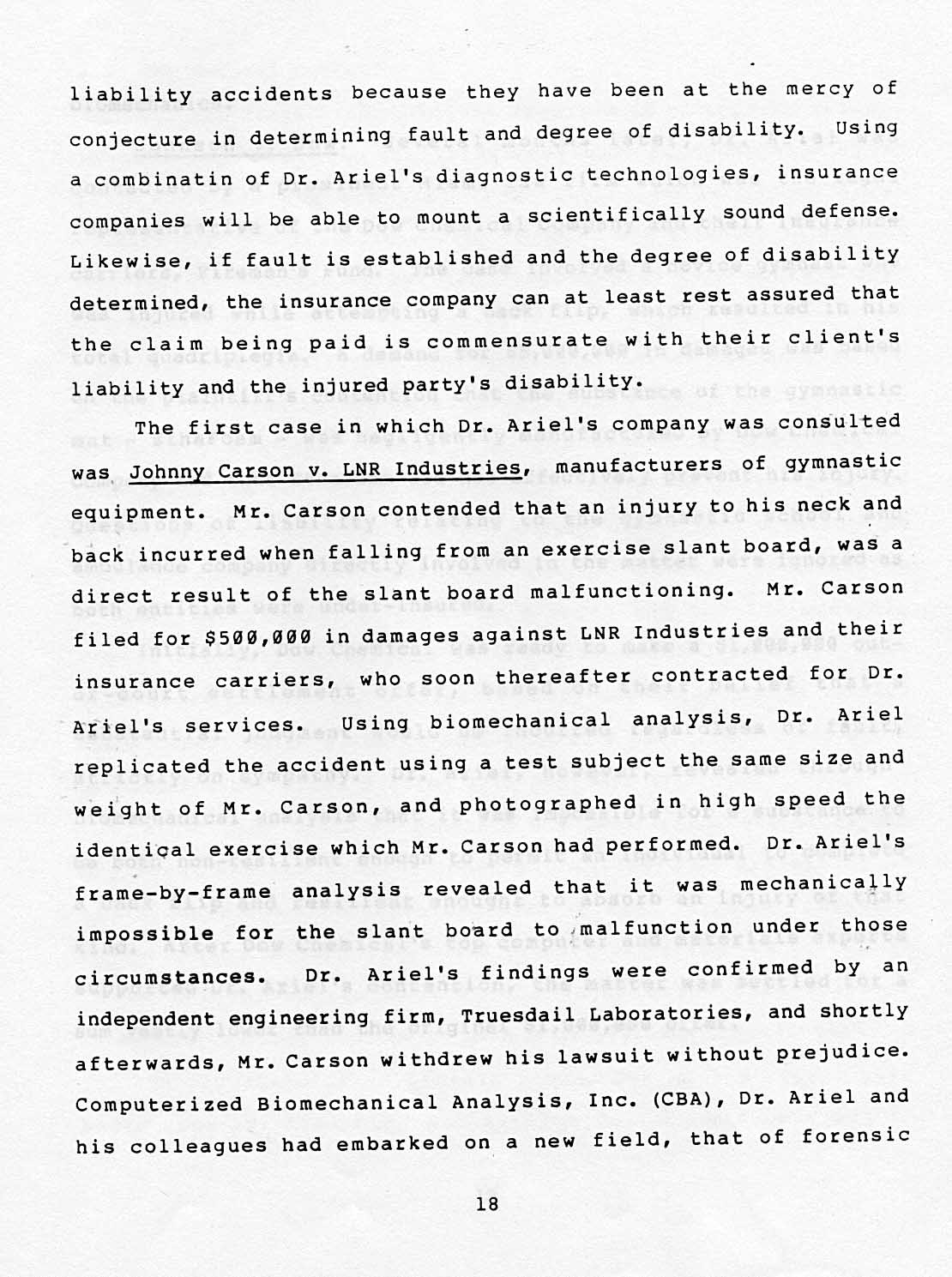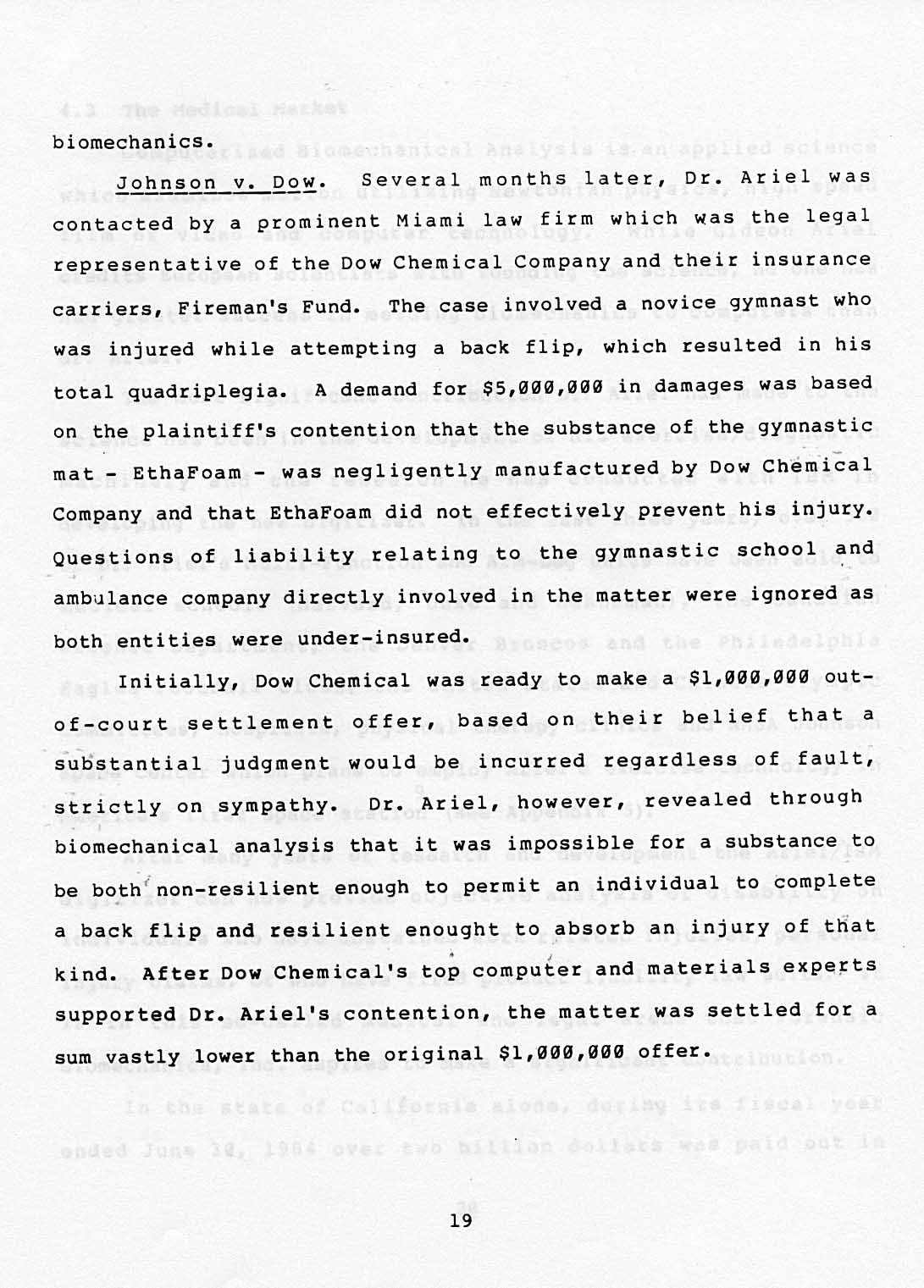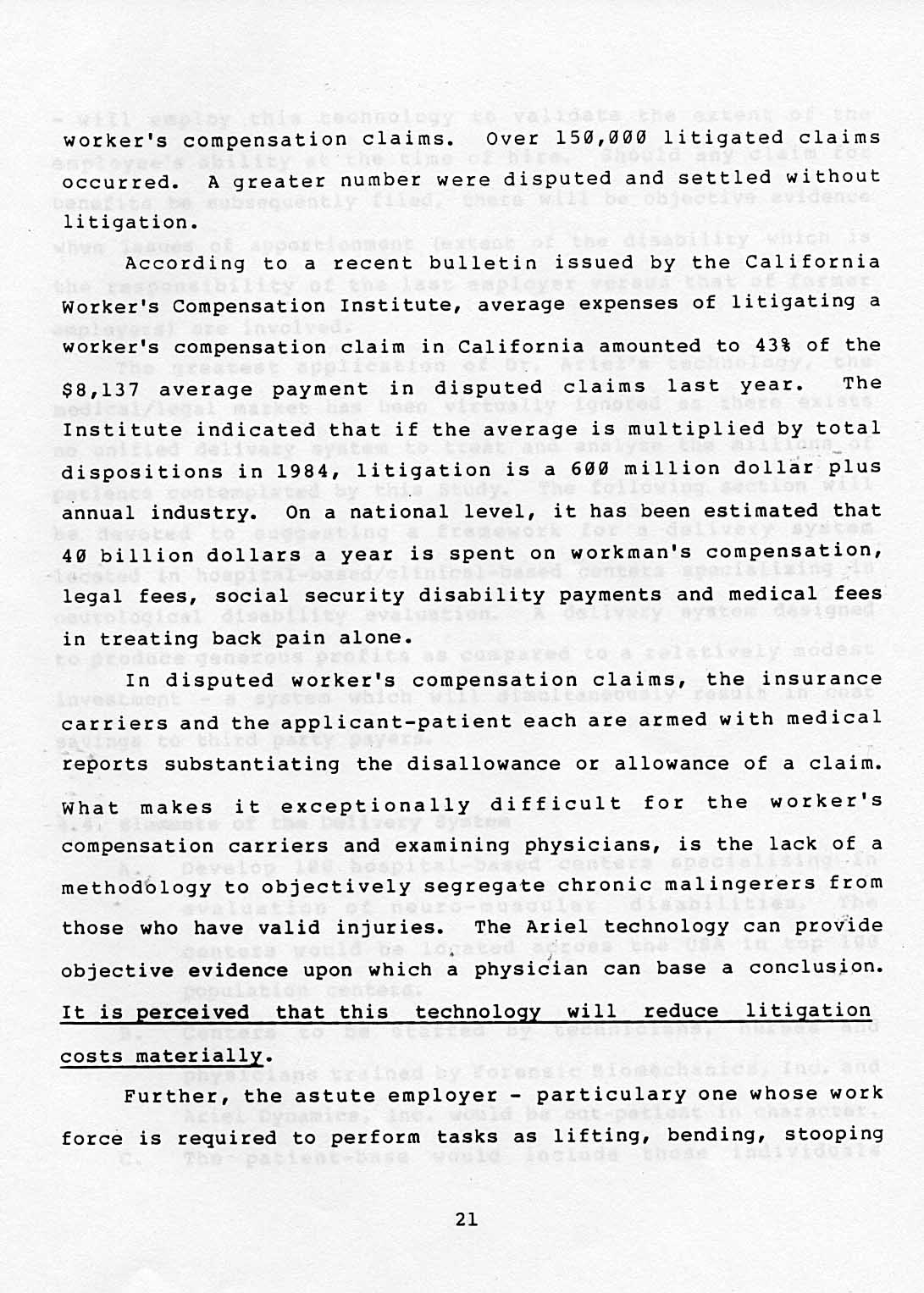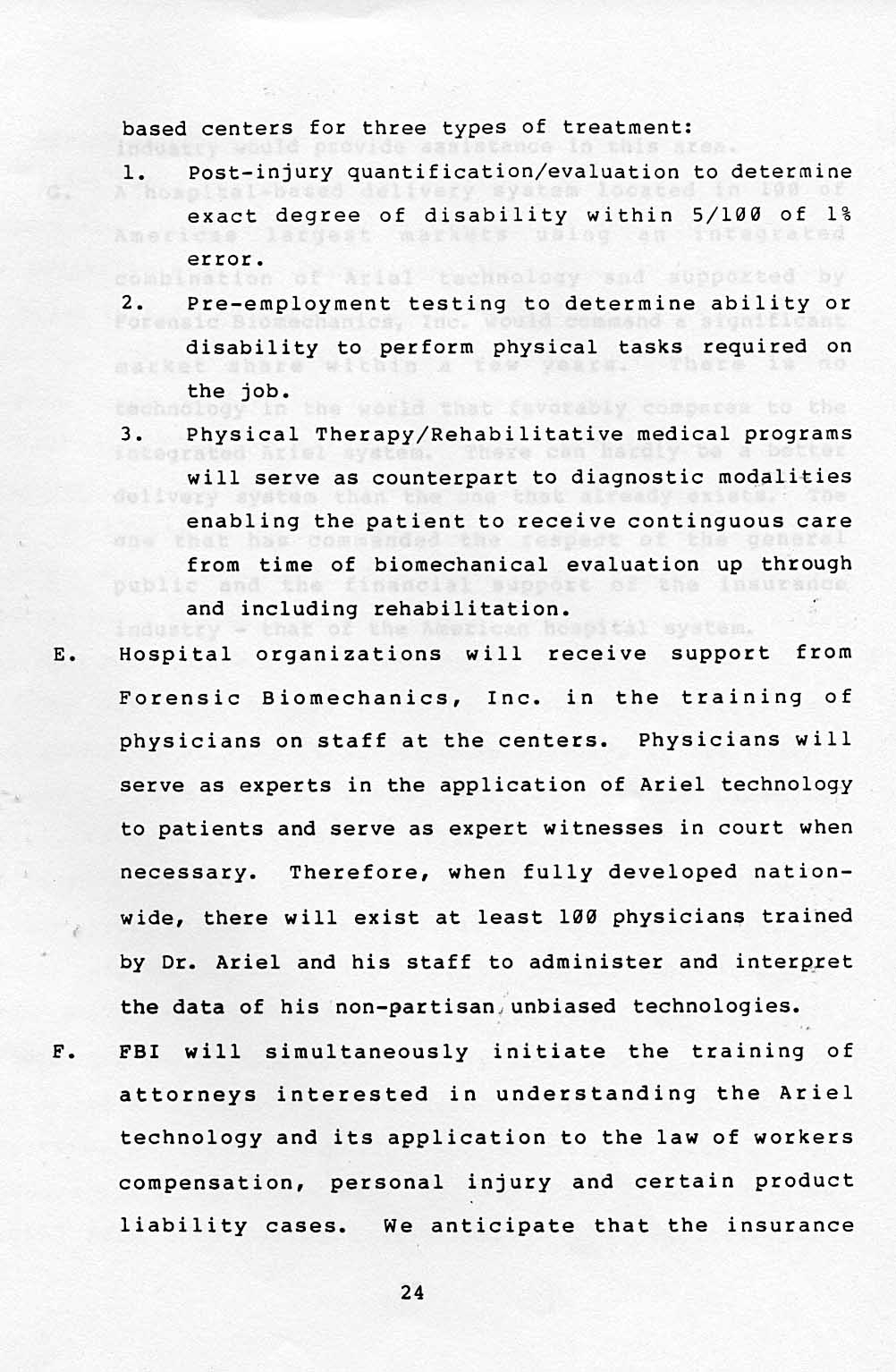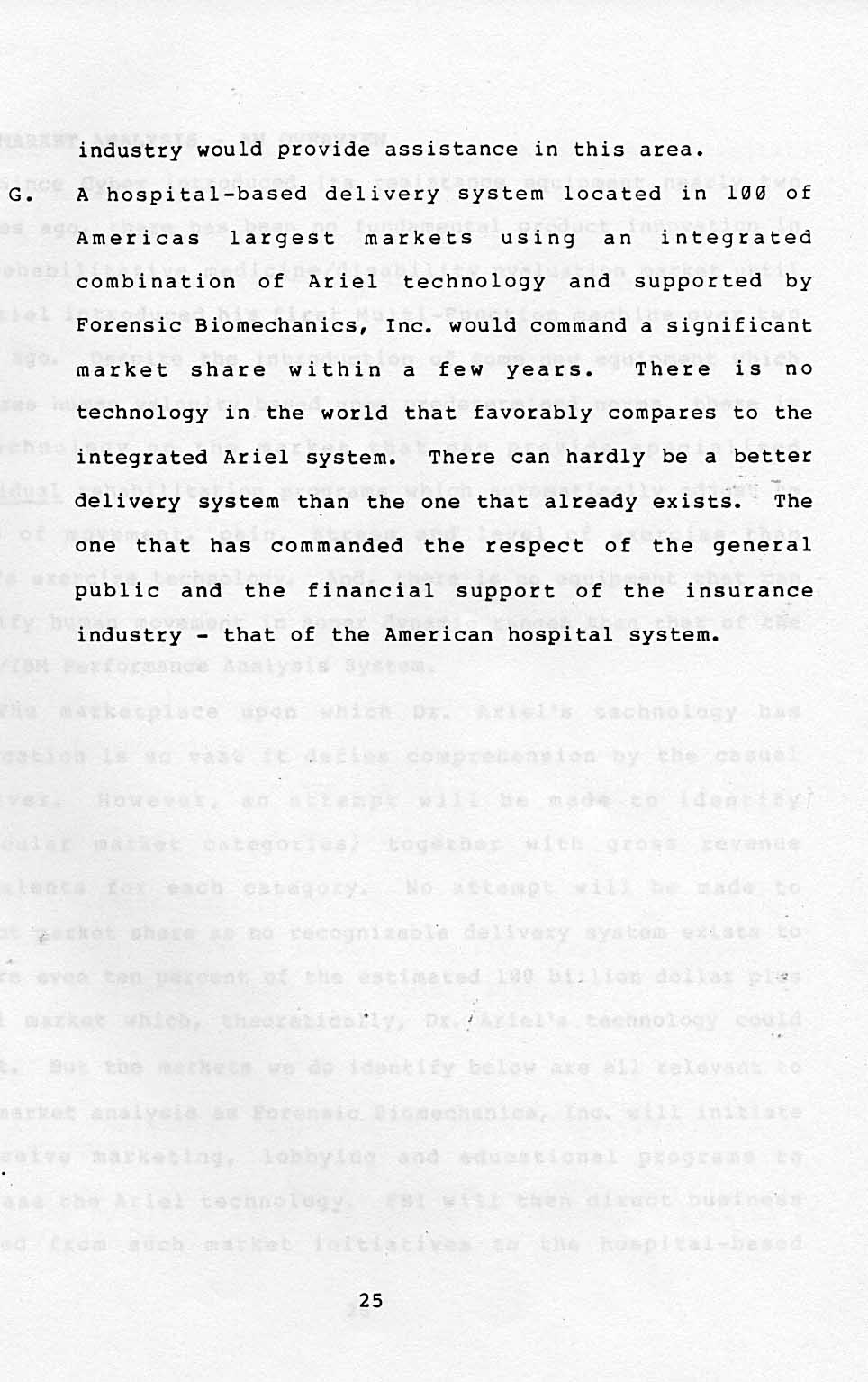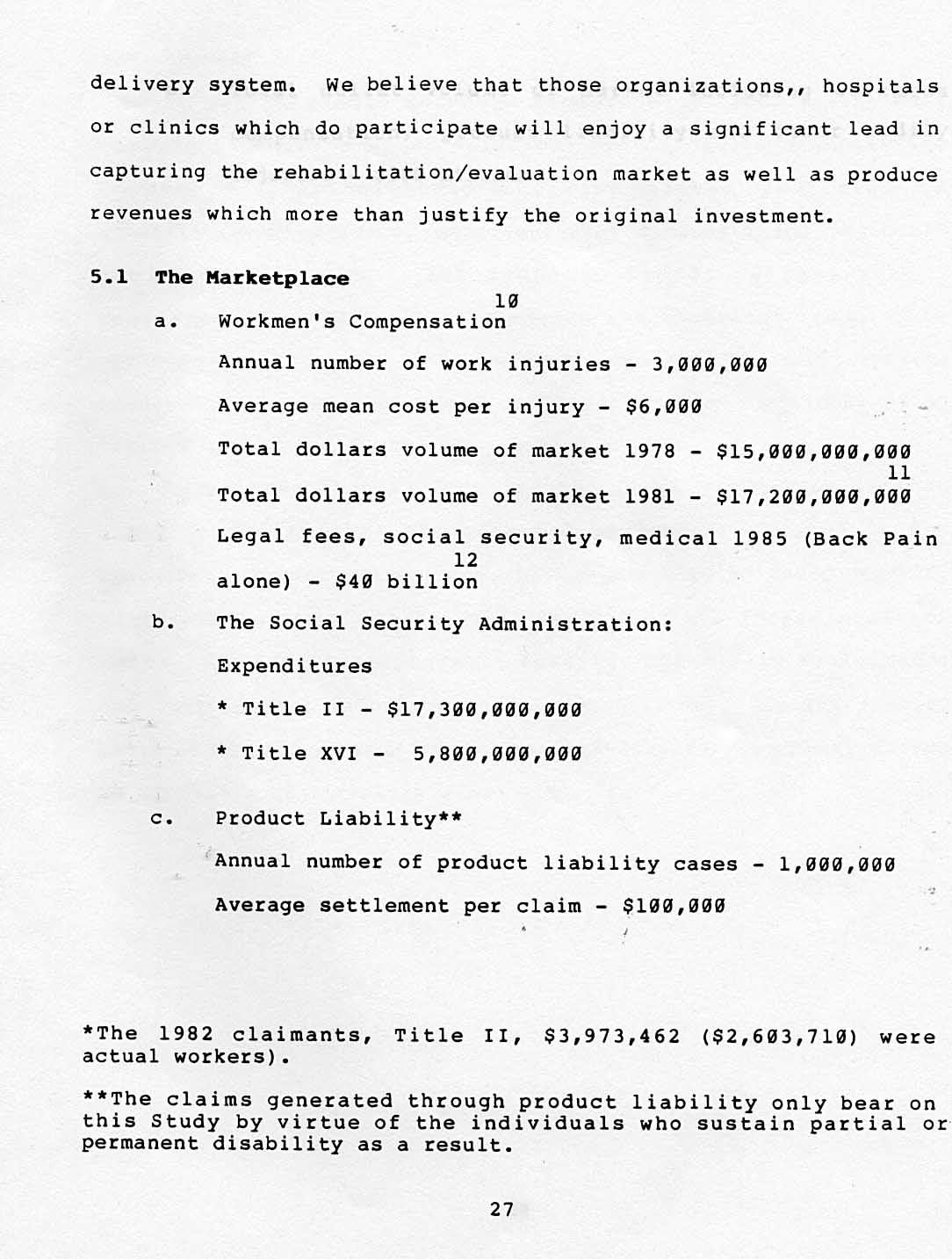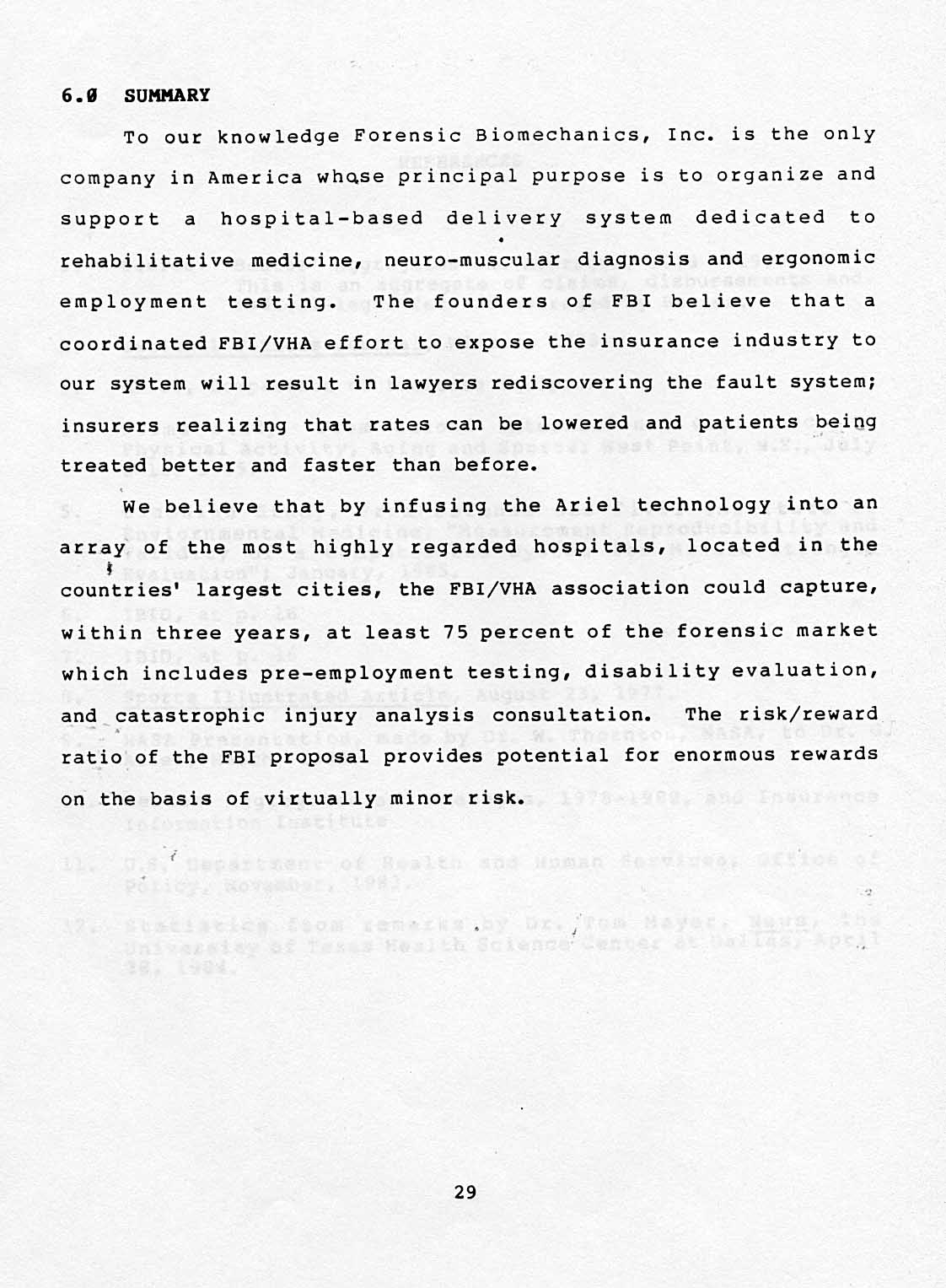Applications of Computerized Biomechanical Analysis to the Medical-Legal Marketplace
Forensic Biomechanics Inc.'s (FBI) mission is to serve the medical, legal and insurance industries.
By FBI Inc. in Forensic Biomechanics Inc. on Wednesday, April 1, 1987
Article Synopsis
The article titled "Applications of Computerized Biomechanical Analysis to the Medical-Legal Marketplace" by Forensic Biomechanics, Inc. discusses the application of Ariel technology in the medical, legal, and insurance industries. The Ariel technology includes computerized exercise/diagnostic equipment and the Ariel Performance Analysis System. The technology aims to provide accurate diagnosis and measurement of disability, and offer effective rehabilitation programs.
The article also discusses the establishment of a nationwide hospital-based network of diagnostic, rehabilitative, and evaluation centers. The technology will be used to educate the forensic-medical community about its validity and superiority in evaluating human disability.
The article further discusses the background of Forensic Biomechanics, Inc., the application of Ariel technology, and the people involved in the project. The technology and market overview, validation of technology, and an overview of legal cases are also discussed. The article concludes with a market analysis and a summary.
The Canadian government commissioned a study to test the Ariel CEM technology for assessing the fitness of its military personnel. The technology was found to be accurate, durable, versatile, and capable of testing large numbers of individuals in a short period of time. The Ariel Computer Exercise System was subsequently purchased by the Canadian government. The technology was also found to be highly suitable for use in hospitals where quick and precise measurements and evaluations are required. The Ariel technology was initially deficient in analyzing and testing small muscle groups, but this issue has been resolved with the development of new attachments. The technology has also been used in legal cases to provide scientifically sound evidence in determining fault and degree of disability. The Ariel technology has potential applications in the medical and legal fields, particularly in evaluating work-related injuries, personal injury claims, and product liability lawsuits.
Tip: use the left and right arrow keys
APPLICATIONS OF COMPUTERIZED BIOMECHANICAL ANALYSIS TO THE MEDICAL-LEGAL MARKETPLACE
PREPARED BY FORENSIC BIOMECHANICS, INC.
December 19, 1985
CONFIDENTIAL
TABLE OF CONTENTS
Pa e
1.0 PURPOSE 1
2.0 BACKGROUND 4
3.0 SUMMARY OF FORENSIC APPLICATION OF ARIEL
TECHNOLOGY 5
3.1 Project 7
3.2 Project Objective 7
3.3 People 7
4.0 TECHNOLOGY AND MARKET - AN OVERVIEW 10
4.1 Validation of Technology 13
4.2 Overview of Legal Cases 17
4.3 The Medical Market 20
4.4 Elements of the Delivery System 22
5.0 MARKET ANALYSIS - AN OVERVIEW 26
5.1 The Marketplace 27
6.0 SUMMARY 29
REFERENCES
APPENDICES
1.0 PURPOSE
Forensic Biomechanics Inc.'s (FBI) mission is to serve the medical, legal and insurance industries by introducing its technologies to a unified delivery system made up of many of the nations most highly respected hospitals.
Forensic Biomechanics Inc. has as its principal objectives:
To introduce to a national hospital system or systems ("the System") the Ariel computerized exercise/diagnostic equipment and the Ariel Performance Analysis System as the stateof-the-art technology to diagnose and measure disability and provide pervasive rehabilitation programs.
To effect the sale of Ariel authored computer hardware and software packages to the System. The equipment to be marketed will include the Ariel computerized exercise/diagnostic machines ("CEM") and the Ariel/IBM Performance Analysis System ("digitizer"); the combined package referred to as "the Ariel technology".
To establish in conjunction with the System a nation wide hospital-based network of diagnostic, rehabilitative and evaluation centers ("the Centers"), located in the USA's larger population centers.
To educate and train personnel in the operation and utilization of the Ariel technology. To further this objective FBI will provide the hospital based Centers with testing protocols, objectives and procedures. The personnel to be trained will include physicians, technicians, nursing
1
coordinators, etc. who will staff the Centers and serve as physical therapists, disability evaluators and medical-legal experts capable of testifying in disability evaluation proceedings.
To educate the forensic-medical community, (casualty insurance carriers, workers' compensation carriers, attorneys, physicians specializing in forensic medicine and others) as to the validity and superiority of the Ariel technology in the precise evaluation of human disability and the greater potential for individual rehabilitation it affords.
To induce the forensic-medical community to process the disability evaluations as to all claims for disability reimbursement or compensation through FBI and the Systems' Centers.
To link the Ariel technology within the System to a central FBI computer which will (i) have the ability to scan the
procedures and (ii) collate data from each of the Centers pertaining to rehabilitation, diagnostic evaluation and forensic use of the technology. Drawing from this organized data base, FBI will continually update and upgrade its proprietary software based upon the patient information collected from the Centers and make these improvements regularly available to the System. As soon as is practical FBI will publish a periodical which will identify industry trends, highlight new applications of the
data to ensure compliance with protocol,
objectives and
technology and, generally, amplify the needs and concerns of the Company's system-wide colleagues.
To coordinate with a national health maintenance organization, such as Voluntary Health Plans of America, in offering the Company's services (e.g. pre-employment testing, "wellness", etc.) on a nationwide basis to labor intensive industry, or to self-insureds via a VHPA program for health resources management.
To develop and market to the System, on a turnkey or lease basis, a "wellness"- sports medicine program utilizing the Ariel technology, influence and experience in training Olympic and professional athletes. These wellness programs will be designed and directed by FBI and will be out-patient in character.
To establish an Advisory Board consisting of leading experts in the various disciplines . . . medical, forensic and
technology and the delivery capabilities of the System and its Centers.
1
insurance
. impacted by the unique qualities of the Ariel
3
2.0 BACKGROUND
One of FBI's principals, Dr. Gideon Ariel, is the father of two technologies referred to in the Business Plan. Dr. Ariel's companies, Ariel Dynamics Inc. ("ADI") and Computerized Biomechanical Analysis ("CBA") will support FBI's marketing, teaching and training initiatives, as well as serve as the primary research and development arm for new software and hardware technologies.
Dr. Ariel's technologies, the Computerized Exercise Machine (CEM) and the Ariel Performance Analysis System (digitizer) have been developed and supported by the Wilson Sporting Goods Company (the CEM) and IBM (the digitizer). ADI is the exclusive distributor of the CEM and the digitizer.
Dr. Ariel's staff coordinates the manufacturing of the CEM in three separate component assembly centers in southern California. The digitizer requires no organic manufacturing as this technology can be made functional merely by linking preexisting components.
4
3.0 SUMMARY OF FORENSIC APPLICATION OF ARIEL TECHNOLOGY
"Faith" is a fine invention. When Gentlemen can see - But Microscopes are prudent In an Emergency.
- Emily Dickinson
Miss Dickinson's verse sums up in four lines the problem and the solutions facing the medical, legal and insurance industries in controlling costs associated with workers compensation claims, catastrophic injury and rehabilitative medicine.
Heretofore, the American legal system looked to experts who offered their opinions as to questions of disability in a nonclinical, often non-scientific, adversarial setting - the courtroom. One expert pitting his reputation against another of equal competence; both offering widely dissimilar opinions representative of which side they are on, plaintiff or defendant.
What is at stake in these situations is the 100 billion dollars a year insurance companies pay claimants, doctors and lawyers to treat and try questions of disability and fault -
questions American law has left up to "faith" and the adversary 1
system.
The system has failed to accurately measure human disability. The resultant costs attributed to payments made to malingerers and to out-of-court settlements based on fear of suffering adverse jury verdicts has caused a crisis which could bankrupt the medical insurance system as we know it.
The medical, legal and insurance industries can no longer
5
rely on a system of evaluating ability and disability based on educated guesses. We must look to objective, unbiased scientific evaluation systems which can objectify what was previously an expert's conjecture. We must indentify a system which can quantify human movement empirically. A system which can cull out the malingerer; a system which can test an employee's capabilities to determine whether he or she can perform required tasks; a system which can provide rehabilitative and therapeutic programs for those who deserve to be treated by the state-of-theart in rehabilitative medicine.
Emily Dickinson had never heard of the science of computerized biomechanical analysis, or its spiritual founder, Dr. Gideon Ariel. But Miss Dickinson's 19th century poem underscores a 20th century problem that can be solved by Dr. Ariel's science and two of his technologies: his programmable computerized exercise/diagnostic machinery and the high speed digitizing unit which he has developed with IBM. These technologies, when integrated, will serve as the ergonomic analogue to the polygraph. However, while the polygraph cannot be admitted in court, Dr. Ariel's technology is admissible.
This Study contemplates t-he incorporation of Dr. Ariel's integrated technologies into a hospital-based system by establishing diagnostic/rehabilitative medicine centers in not less than 100 markets correlative to the countries' greatest population centers. When fully operational the System will generate substantial revenues for those hospitals whose
6
representatives are willing to recognize an economic opportunity; are interested in providing patients with state-of-the-art care; and, are sensitive to the insurers' need to reduce costs.
3.1 Project
To establish high profile and profitable neuro muscular/diagnostic centers with compatible rehabilitative medicine capabilities in the United States' top 100 markets. Forensic Biomechanics, Inc. will provide support to the centers through educational programs, trade shows and professional meetings and seminars.
3.2 Project Objective
To establish a delivery system utilizing Dr. Ariel's technologies through the sale of hardware and software packages to hospital-based end user(s). End user will enter into licensing and/or joint venture agreements with FBI.
There are several markets for Dr. Ariel's technologies, each of which requires an in-depth market study and plan setting forth the capital resource requirements for producing and marketing products tailored to that market. All of these options will be examined and those found to be viable will be pursued.
3.3 People
The Principals in the Forensic Biomechanics, Inc. management
7
Gideon Ariel, Biomechanics Director. Dr. Ariel is the world's leading pioneer in Biomechanics and Sports Analysis, according to the 2 National Fitness Journal. He has been developing the Ariel
computerized exercise machine and high speed film analysis for the last 15 years. A former discus thrower for the Israeli Olympic team, he has devoted his life to the science of exercise and movement. He has earned two B.S. degrees, from Wingate College, Tel Aviv, Israel, and the University of Wyoming. He holds a Ph.D. in Exercise Science, as well as a Post Doctorate in Computer Science from the University of Massachusetts. He is past Chairman of the Biomechanics Committee of the U.S. Olympic Committee. Dr. Ariel owns and operates two companies from Coto de Caza, California, devoted to research and development of sports medicine, rehabilitation, and ergonomic evaluation.
Douglas Dunlop, CEO. Mr. Dunlop and Dr. Ariel introduced forensic biomechanics to the legal profession in the late '70's. Together with Dr. Ariel, Mr. Dunlop instituted the first Olympic Training Center and Sports Medicine Center at Squaw Valley, California in 1977. Mr. Dunlop received a B.A. from the University of New Mexico and a J.D. from Indiana University Law School. His professional experience has concentrated in sports, corporation and securities law. He has worked for the National Collegiate Athletic Association (NCAA) Enforcement Division, the United States Olympic Committee (USOC) as Counsel, and he has
8
been in private practice in Indianapolis, Indiana. Mr. Dunlop is a member of the Panel of Arbitrators of the American Arbitration Association (AAA), New York, N.Y., is admitted to practice in the State of Indiana, the Federal District Court of Indiana, Southern Division and the Ninth Circuit Court of Appeals.
Scott Dunlop, Marketing Director. Scott Dunlop is presently Senior Manager of Special Projects for Fuji Photo Optical Company, Ltd. with responsibility for development and monitoring of medical-industrial instrumentation. Mr. Dunlop has seven years of experience with Fuji and two years in medical sales with Seamless Hospital Products of Connecticut. He represents Fuji with regard to all FDA matters involving the medical/industrial products division. Mr. Dunlop holds a degree in Business Administration from Bimidji State University in Minnesota.
9
4.0 TECHNOLOGY AND MARKET - AN OVERVIEW Dr. Ariel's companies, Computerized Inc. and Ariel Dynamics, are located in
led the way in biomechanical research, sports product development and analysis of legal cases since 1971.
The California research center is located approximately one and one-half hours south of Los Angeles at Coto de Caza, California, a resort at the foot of the Saddleback Mountains. The Amherst lab, where much of the computer programming takes
place, is located about one hour from Hartford, Connecticut. Dr. Ariel's team of nationally recognized scientists and research engineers all have contributed in pioneering the most advanced physical fitness and rehabilitation system on the market. After many years of research and development, the Ariel system of human disability evaluation and rehabilitation transcends all other
standard methods of rehabilitation and is years ahead of the nearest competiton.
The Ariel computerized exercise/rehabilitation technology employs sturdy digital hydraulic resistor packages instead of
and Coto de Caza, California.
Biomechanical Analysis, Amherst, Massachusetts
Dr. Ariel and his colleagues have
weights, spring or manually-adjusted hydraulic or pneumatics resistance to insure safety, quietness and efficiency. By using color graphics monitors to illustrate the individual's exercise performance, the user can follow a predetermined exercise program or create a physical profile relating to each individual's
10
strengths, weaknesses, speed and endurance.
Specifically, Ariel employs two machines designed for diagnostic testing and programmable variable resistance exercise: the Multi-Function and the Arm-Leg machines. Two new devices, the back machine (with attachments for small muscle analysis) and the rowing machine, will be commercially available in the next several months. All of Dr. Ariel's technologies are "user friendly" and utilize "Assembly" computer language.
The Ariel Arm-Leg machine concentrates on exercises specifically geared for the muscle groups in the arms and legs, including: the biceps, triceps, quadriceps, and hamstrings. As a complement to the Ariel Multi-Function machine, the Arm-Leg gives the user a large selection of exercises for personal fitness, rehabilitation, sports training and research..
Accommodating resistence is possible through a computercontrolled bio-feedback loop which enables an individual to tailor a personal program to suit one's variable velocity and force. To make the exercise more meaningful, the individual can monitor each performance and directly compare that workout to previous ones.
Equipped with an ergonomically-designed seating station, the Ariel Arm-Leg machine has a common pivot that allows the arms and the legs to be exercised on the same unit.
The Arm-Leg unit enables each limb to be exercised either independently or together. With this feature, the Arm-Leg unit is able to build and tone up the muscles in the shoulders,
11
abdomen, triceps, forearms, thighs, knees and calves.
The Ariel Multi-Function unit provides the individual with personal fitness, sports training, rehabilitation and research with exercises for the major muscle groups found in the entire body. The bio-feedback loop allows the user to accomplish accommodating resistance throughout the full range of motion. A special feature to the adaptable Multi-Function unit gives the individual the ability to personally tailor the variable velocity or force factor. The user's performance then can be monitored during the exercise and compared to previous workouts.
The Multi-Function unit contains the same computerized measurement features that its Arm-Leg companion has. These measurements include resistance, velocity, work and fatigue values. This information is all illustrated on a graphics monitor and printed out on a computer printer.
For years Dr. Ariel has used computerized biomechanical analysis to study athletes and personal injury surrogates using high speed film cameras at thousands of frames per second, digitizing the developed film with a sonic pen on an electrified screen which then feeds data on the subject to a computer. This computer is programmed to answer questions as to ability or disability. The legal cases (discussed below) using computerized biomechanical analysis proved to be the crucial factor in each case analyzed.
Now, a collaboration between Dr. Ariel and IBM has produced
12
the new Ariel Performance Analysis System. This sytem has the capability of analyzing any subject anywhere the high speed shutter video cameras can be carried. This compact computerdigitizer saves the user hours of laborious digitizing by sonic pen as the Ariel/IBM model searches out digitizing points on the subject seen on the video monitor automatically, in a matter of minutes. The new IBM hardware which has replaced the over-sized
mainframe computers is now console-sized and suitable for desk top use. The cost, too, has been dramatically reduced from about $1,000,000 per unit for the old mainframe model, to about $80,000 for the Ariel/IBM including programs and other accessories.
The Ariel/IBM programs are not "software" per se, but rather hard disks which cannot be separated from the console. Therefore, the Ariel Performance Anal sis System defies duplication.
4.1 Validation of Technology
Several independent studies have been conducted which validate Dr. Ariel's computerized exercise machines (CEM) as well as his computerized biomechanical analysis high speed film
system. In each study the Ari,el equipment and technology were tested under scientific and/or clinical conditions by individuals
and groups as varied as an American cardiologist from New York, to a Canadian environmental medicine team, and a Los Angelesbased engineering company which specializes in analyzing
scientific aspects of legal cases.
13
Dr. Ariel has also conducted a comparison study of his exercise/diagnostic equipment (see Appendix 1), which examines
many of the leading exercise/rehabilitative equipment packages on 3
the market. Additionally, Dr. Ariel has received substantial
positive feedback from two medical schools which have used the CEM: Harvard Medical School and the Hahnemann Medical School.
The West Point Study. As recently as July, 1985, Dr. Tobia A. Palma, F.A.C.C., F.C.C.C. and a Board Certified cardiologist presented the results of tests using Dr. Ariel's CEM to the 2nd International Conference on Physical Activity, Aging and Sports
at West Point, New York. Dr. Palma studied 22 patients with ASHD, 13 M.I., 6 C.A.B.G., 2 Angina Syndrome, 1 Percutaneous Transluminal Coronary Angioplasty (PTCA). The study revealed
that a population of patients with these maladies could be studied safely on Ariel's CEM utilizing lifting maneuvers. There were no significant adverse effects demonstrated in B.P., H.R., clinical sysmptoms or arhythmias.
The text of Dr. Palma's study is included in its entirety (please see Appendix 2). However, for purposes of identifying
some of Dr. Palma's remarks which have particular relevance to 4 this Study, we offer the following excerpts:
". . . we have embarked on a new assessment of cardiac assessment and rehabilitative efforts."
"The Ariel Computerized Exercise System has revolutionized the whole field of muscle dynamics and exercise physiology. In a world where computers serve as decisive tools for
14
launching space craft, we now have a computer assessment of load capability, variable velocity and fatigue."
"The questions on work evaluation forms regarding lifting 25 or 50 pounds, etc. can now be answered legitimately rather than by a 'whimsical educated guess.'"
". the Ariel Computerized Exercise System not only serves as the diagnostic and rehabilitative tool, allowing one to train the individual for deficits and capability, but also as an approach in industry, speeding the return of workers to their job status in an effective and safe manner. (Emphasis added).
The Canadian Study. Recently, the Canadian government directed its Defense and Civil Institute of Environmental
Medicine to study the Ariel CEM technology for purposes of 5 testing the fitness of the Canadian military. The Canadian
government wanted to purchase technology that was accurate, durable, possessed research capabilities, and was versatile enough to treat and examine large numbers of individuals. An intensive scientific evaluation of the Ariel CEM was conducted (see Appendix 3 for the entire report). After examining all the various, skeletal muscle strength testing apparati commercially available, the Ariel Computer Exercise System was purchased by the Canadian government.
The Canadian study is descriptive in nature, concentrating on equipment design and operation, validity and reproducibility of forces, validity and reproduciblity of angular velocity and force, as well as torques during various exercises. Of particular interest is the finding made by the Canadian
15
scientists that the Ariel technology is the most adaptable
equipment for "testing large numbers of subjects in a relatively 6
short period of time." Therefore, the Canadian Study reinforces
the position of the preparer of this Study that the Ariel technology is highly appropriate for use in hospitals with high census' where precise measurements and evaluations are required quickly.
Other relevant remarks excerpted from the Canadian study are 7
offered below:
"Our experience to date with the ACE (Ariel technology) confirms that it performs valid and reproducible force measurements. When used for testing isokenetic muscle strength, it limits angular velocity to a userspeficied velocity with a high degree of precision and reliability."
"In light of the measurement reproducibility and a validity documented in this report, the ACE can be confidently used for research."
"A particular advantage of the ACE for mass testing is the software control which permits testing protocols and results to be stored and assessed via micro-computer."
The Candian Study cited the Ariel technology as being deficient in the analysis and testing of small muscle groups. However, Dr. Ariel has solved this problem by developing attachments to the Arm-Leg machine allowing many more smaller muscle groups to be tested. Therefore, the arm, wrist, shoulder - indeed all of the major joints - will be subject to accurate analysis via the Ariel Arm-Leg attachments within the next several months.
16
The Los Angeles Study and other comments. This study was associated with the injury suffered by Johnny Carson, discussed in 4.2 of this Study. As mentioned above, Truesdail Laboratories confirmed Dr. Ariel's computerized biomechanical analysis of a Carson surrogate replicating the accident; that the maker of the exercise slant board was not at fault. A copy of the report is available upon request.
Additionally, other legal cases where Dr. Ariel has been consulted will be made available upon request.
In the last two years, the IBM Corporation has spent several hundred thousand dollars in the development of the Ariel Peformance Analysis System. This system is the second
generation of its forerunner which Sports Illustrated referred to 8
as the ". . . magic machine." (See Exhibit 4).
Please see the book accompanying this Study for further compilations of remarks on the technology entitled Gideon Ariel and His Magic Machine, selected reprints from National Publications.
4.2 Overview of Legal Cases
The ramifications of utilizing computerized biomechanical analysis in analyzing and quantifying human disability are as enormous as the size of this multi-billion dollar marketplace. Until now insurance companies have paid excessive awards for catastrophic accidents, workers compensation and product
17
liability accidents because they have been at the mercy of conjecture in determining fault and degree of disability. Using a combinatin of Dr. Ariel's diagnostic technologies, insurance companies will be able to mount a scientifically sound defense. Likewise, if fault is established and the degree of disability determined, the insurance company can at least rest assured that the claim being paid is commensurate with their client's liability and the injured party's disability.
The first case in which Dr. Ariel's company was consulted was Johnny Carson v. LNR Industries, manufacturers of gymnastic equipment. Mr. Carson contended that an injury to his neck and back incurred when falling from an exercise slant board, was a direct result of the slant board malfunctioning. Mr. Carson filed for $500,000 in damages against LNR Industries and their insurance carriers, who soon thereafter contracted for Dr.
Ariel's services. Using biomechanical analysis, Dr. Ariel replicated the accident using a test subject the same size and weight of Mr. Carson, and photographed in high speed the identical exercise which Mr. Carson had performed. Dr. Ariel's frame-by-frame analysis revealed that it was mechanically impossible for the slant board to malfunction under those circumstances. Dr. Ariel's findings were confirmed by an independent engineering firm, Truesdail Laboratories, and shortly afterwards, Mr. Carson withdrew his lawsuit without prejudice. Computerized Biomechanical Analysis, Inc. (CBA), Dr. Ariel and his colleagues had embarked on a new field, that of forensic
18
biomechanics.
Johnson v. Dow. Several months later, Dr. Ariel was contacted by a prominent Miami law firm which was the legal representative of the Dow Chemical Company and their insurance
carriers, Fireman's Fund. The case involved a novice gymnast who was injured while attempting a back flip, which resulted in his total quadriplegia. A demand for $5,000,000 in damages was based
on the plaintiff's contention that the substance of the gymnastic mat - EthaFoam - was negligently manufactured by Dow Chemical Company and that EthaFoam did not effectively prevent his injury. Questions of liability relating to the gymnastic school and
ambulance company directly involved in the matter were ignored as both entities were under-insured.
Initially, Dow Chemical was ready to make a $1,000,000 outof-court settlement offer, based on their belief that a substantial judgment would be incurred regardless of fault, strictly on sympathy. Dr. Ariel, however, revealed through biomechanical analysis that it was impossible for a substance to be both non-resilient enough to permit an individual to complete
a back flip and resilient enought to absorb an injury of that kind. After Dow Chemical's top computer and materials experts supported Dr. Ariel's contention, the matter was settled for a sum vastly lower than the original $1,000,000 offer.
19
4.3 The Medical Market
Computerized Biomechanical Analysis is an applied science which examines motion utilizing Newtonian physics, high speed film or video and computer technology. While Gideon Ariel credits European scientists with founding the science, no one has had greater success in melding biomechanics to computers than Dr. Ariel.
The most significant contribution Dr. Ariel has made to the science has been in the development of his exercise/diagnostic machinery and the research he has conducted with IBM in developing the new digitizer. In the last three years, over 300 of Dr. Ariel's Multi-Function and Arm-Leg units have been sold to medical schools (Harvard, Duke and Hahneman), the Canadian Defense Department, the Denver Broncos and the Philadelphia Eagles Football Clubs, the United States and Chinese Olympic Committees, hospitals, physical therapy clinics and NASA Johnson
Space Center which plans to employ Ariel's exercise technology in 9
America's first space station (see Appendix 5).
After many years of research and development the Ariel/IBM digitizer can now provide objective analysis of disability on individuals who have sustained work related injuries, personal injury claims, or who have filed product liability law suits. It is in this so-called medical and legal arena that Forensic Biomechanics, Inc. aspires to make a significant contribution.
In the state of California alone, during its fiscal year ended June 30, 1984 over two billion dollars was paid out in
20
worker's compensation claims. Over 150,000 litigated claims occurred. A greater number were disputed and settled without litigation.
According to a recent bulletin issued by the California Worker's Compensation Institute, average expenses of litigating a worker's compensation claim in California amounted to 43% of the $8,137 average payment in disputed claims last year. The Institute indicated that if the average is multiplied by total dispositions in 1984, litigation is a 600 million dollar plus annual industry. On a national level, it has been estimated that 40 billion dollars a year is spent on workman's compensation, legal fees, social security disability payments and medical fees in treating back pain alone.
In disputed worker's compensation claims, the insurance carriers and the applicant-patient each are armed with medical reports substantiating the disallowance or allowance of a claim. What makes it exceptionally difficult for the worker's compensation carriers and examining physicians, is the lack of a methodology to objectively segregate chronic malingerers from those who have valid injuries. The Ariel technology can provide objective evidence upon which a physician can base a conclusion. It is perceived that this technology will reduce litigation
costs materially.
Further, the astute employer - particulary one whose work force is required to perform tasks as lifting, bending, stooping
21
- will employ this technology to validate the extent of the employee's ability at the time of hire. Should any claim for benefits be subsequently filed, there will be objective evidence when issues of apportionment (extent of the disability which is the responsibility of the last employer versus that of former employers) are involved.
The greatest application of Dr. Ariel's technology, the medical/legal market has been virtually ignored as there exists no unified delivery system to treat and analyze the millions of patients contemplated by this Study. The following section will be devoted to suggesting a framework for a delivery system located in hospital-based/clinical-based centers specializing in neurological disability evaluation. A delivery system designed to produce generous profits as compared to a relatively modest investment - a system which will simultaneously result in cost savings to third party payers.
4.4 Elements of the Delivery System
Develop 100 hospital-based centers specializing in evaluation of neuro-muscular disabilities. The centers would be located across the USA in top 100 population centers.
Centers to be staffed by technicians, nurses and
physicians trained by Forensic Biomechanics, Inc. and
Ariel Dynamics, Inc. would be out-patient in character. C. The patient-base would include those individuals
22
requiring quantification of partial disability as seen in workers compensation cases, catastrophic injury and those patients injured as a result of certain product liability cases. The centers would also serve as local-regional screening agents for industries whose employees use dynamic ranges of motion, endurance and strength to accomplish their work tasks. The professions and vocations that would rely on the hospital-based centers for pre-employment, post-injury testing and rehabilitative treatment include: nurses, garbage men, steel workers, pipe layers, longshoremen, construction workers, etc., as well as companies in general seeking to reduce workers compensation claims and disability claims. Finally, the Federal and State governments seeking to reduce compensation claims, i.e.
administration, OSHA, the Department of Transportion would direct cases to the centers.
- FBI and the hospital organization will present validation of the Ariel technology to insurance companies and relevant labor intensive industries
interested in reducing workers compensation and disability claims. Insurance companies and labor intensive industry will then direct insureds and
employees to be tested at the hospital-based clinical
state industrial boards,
the social security
23
based centers for three types of treatment:
- Post-injury quantification/evaluation to determine
exact degree of disability within 5/100 of 1%
error.
Pre-employment testing to determine ability or disability to perform physical tasks required on the job.
Physical Therapy/Rehabilitative medical programs will serve as counterpart to diagnostic modalities enabling the patient to receive continguous care from time of biomechanical evaluation up through and including rehabilitation.
- Hospital organizations will receive support from Forensic Biomechanics, Inc. in the training of physicians on staff at the centers. Physicians will serve as experts in the application of Ariel technology to patients and serve as expert witnesses in court when necessary. Therefore, when fully developed nationwide, there will exist at least 100 physicians trained by Dr. Ariel and his staff to administer and interpret
the data of his non-partisan: unbiased technologies.
- FBI will simultaneously initiate the training of attorneys interested in understanding the Ariel technology and its application to the law of workers compensation, personal injury and certain product liability cases. We anticipate that the insurance
24
G.
industry would provide assistance in this area.
A hospital-based delivery system located in 100 of Americas largest markets using an integrated combination of Ariel technology and supported by Forensic Biomechanics, Inc. would command a significant market share within a few years. There is no technology in the world that favorably compares to the integrated Ariel system. There can hardly be a better delivery system than the one that already exists. The one that has commanded the respect of the general public and the financial support of the insurance industry - that of the American hospital system.
25
5.0 MARKET ANALYSIS - AN OVERVIEW
Since Cybex introduced its resistance equipment nearly two decades ago, there has been no fundamental product innovation in the rehabilitative medicine/disability evaluation market until Dr. Ariel introduced his first Multi-Function machine over two years ago. Despite the introduction of some new equipment which
measures human velocity based upon predetermined norms, there is no technology on the market that can provide specialized individual rehabilitation programs which automatically adjust to range of movement, pain, stress and level of exercise than Ariel's exercise technology. And, there is no equipment that can quantify human movement in super dynamic ranges than that of the Ariel/IBM Performance Analysis System.
The marketplace upon which Dr. Ariel's technology has
application is so vast it defies comprehension by the casual observer. However, an attempt will be made to identify particular market categories, together with gross revenue equivalents for each category. No attempt will be made to project market share as no recognizable delivery system exists to capture even ten percent of the estimated 100 billion dollar plus annual market which, theoretically, Dr. Ariel's technology could impact. But the markets we do identify below are all relevant to
this market analysis as Forensic Biomechanics, Inc. will initiate aggressive marketing, lobbying and educational programs to showcase the Ariel technology. FBI will then direct business dervied from such market initiatives to the hospital-based
26
delivery system. We believe that those organizations,, hospitals or clinics which do participate will enjoy a significant lead in capturing the rehabilitation/evaluation market as well as produce revenues which more than justify the original investment. 5.1 The Marketplace
10
Workmen's Compensation
Annual number of work injuries - 3,000,000
Average mean cost per injury - $6,000
Total dollars volume of market 1978 - $15,000,000,000
11
Total dollars volume of market 1981 - $17,200,000,000
a.
Legal fees, social security, medical 1985 (Back Pain 12
alone) - $40 billion
- The Social Security Administration: Expenditures
� Title II - $17,300,000,000
� Title XVI - 5,800,000,000
- Product Liability**
Annual number of product liability cases - 1,000,000 Average settlement per claim - $100,000
*The 1982 claimants, Title II, $3,973,462 ($2,603,710) were actual workers).
**The claims generated through product liability only bear on this Study by virtue of the individuals who sustain partial or permanent disability as a result.
27
- Total dollar volume of market including workmens compensation, product liability and other bodily injuries - $100 billion
employment t4.3':inz;. Ttie f-fUla..dart rG ?37 tee: '. B'.�> th:: - C orui:; cG� f I;' ttA aUr, r tb xp th.- i s=_aa-:ce tnuu~':~y do
r aid*ttm ; ai $:v cult it % law_Jats 1.d�~ the CA u'
ibsi:rer,R+ rc,,41izirrg t�-,at rat 3 :-An 1 +~
whiCi. inc-L; de'f rz-Lst".i~~i':ticiit t,ast r , ={:AidtbLi1 . "St11i~3ti1>>a. injury Analysis- ,3,'ar! ~d: ribi: `be risk/;ewar.d.
I
- ia-t14- gOI'*nti#I .K !'Y11a. h-l1Sal]-i +1f virtu. 1S-v minim_` T_S9k..
28
6.0 SUMMARY
To our knowledge Forensic Biomechanics, Inc. is the only company in America whose principal purpose is to organize and support a hospital-based delivery system dedicated to rehabilitative medicine, neuro-muscular diagnosis and ergonomic
employment testing. The founders of FBI believe that a coordinated FBI/VHA effort to expose the insurance industry to our system will result in lawyers rediscovering the fault system; insurers realizing that rates can be lowered and patients being treated better and faster than before.
We believe that by infusing the Ariel technology into an array of the most highly regarded hospitals, located in the countries' largest cities, the FBI/VHA association could capture,
within three years, at least 75 percent of the forensic market which includes pre-employment testing, disability evaluation, and catastrophic injury analysis consultation. The risk/reward ratio of the FBI proposal provides potential for enormous rewards on the basis of virtually minor risk.
29
REFERENCES
- Source: Bestes' Aggregates and Averages, 1978 - 1980
This is an aggregate of claims, disbursements and medical-legal fees as averaged by Bestes.
National Fitness Journal, Winter, 1983.
Ariel, Comparison of Exercise Equipment
Palma Study, From Second International Conference on Physical Activity, Aging and Sports; West Point, N.Y., July 8-12, 1985.
Canadian Study, From Defense and Civil Institute of Enviornmental Medicine; "Measurement Reproducibility and Validity of a Computerized System for Muscle Strength Evaluation"; January, 1985.
IBID, at p. 16
IBID, at p. 16
Sports Illustrated Article, August 23, 1977.
NASA Presentation, made by Dr. W. Thornton, NASA, to Dr. G. Ariel, March, 1983.
Bestes' Aggregates and Averages, 1978-1980, and Insurance Information Institute
U.S.'Department of Health and Human Services, Office of Policy, November, 1983.
Statistics from remarks by Dr. Tom Mayer, News, The University of Texas Health Science Center at Dallas, April 30, 1984.

